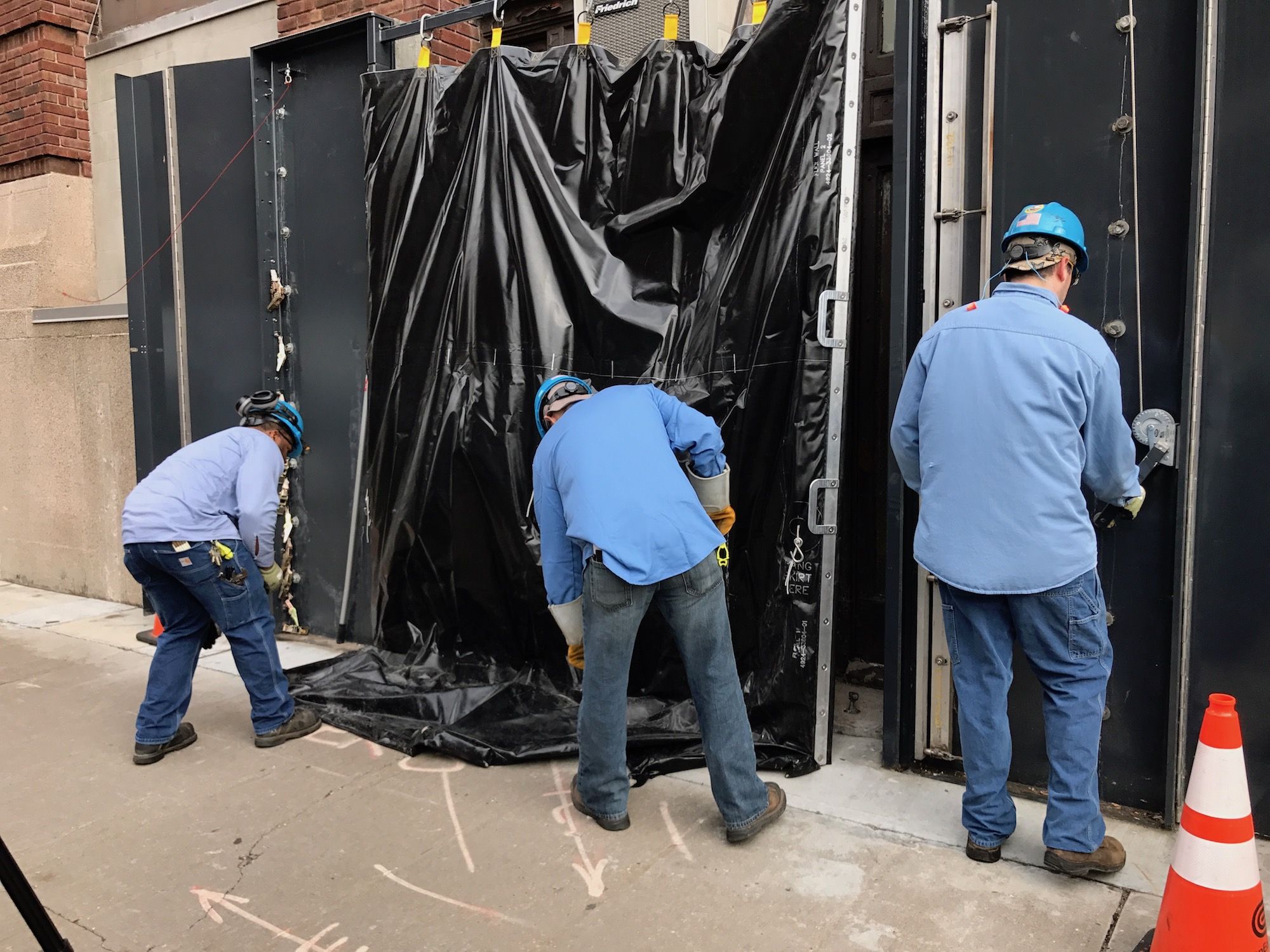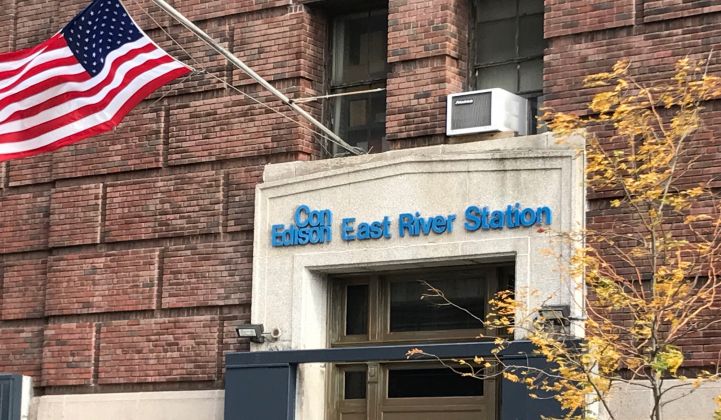At 8:12 p.m. on the night Superstorm Sandy hit Manhattan, the plant manager at Consolidated Edison’s East River substation, Michael Brown, was on a planning call in his fifth floor office when a light-blue arc of electricity from a circuit breaker flashed in the sky.
It extended from the station all the way across FDR Drive to the fast-rising river.
“I was pretty much speechless,” said Brown, standing outside the plant five years later. “If I wasn’t here to see it, I wouldn’t believe it.”
Minutes after the arc appeared, Lower Manhattan went black. A storm surge inundated the protective pumps on the plant’s feeders. The flash was a warning, but ultimately not the cause of the power loss that impacted 1.1 million Con Ed customers. Those customers were sunk into darkness as the water levels reached the station’s control room and relay house, where many of the equipment panels sit close to the floor.
For many parts of the country, and New York City in particular, Sandy was a wake-up call. As Michael Carlson, president of Digital Grid at Siemens, put it: “It was after Sandy that resilience entered the national conversation.” (See GTM's previous e-book on the impact of Sandy on grid planning.)
City planners, regulators and local government were forced to grapple with the threat of increasing storms that blew past previous records. Utilities like Con Ed were pressured to harden their systems and improve response times.
With the five-year anniversary of Superstorm Sandy approaching, America is still grappling with a series of hurricane-related catastrophes in Puerto Rico, Texas and Florida. Meanwhile, California is recovering from devastating fires earlier this month. Conversations about resilience are top of mind for many planners.
For traditional utilities struggling to keep up with a changing grid and threats from natural disasters, Con Ed’s work offers a case study in building back a system after it’s been crippled.
“We thought we were in good shape”
When the storm hit, water rose to over 13 feet at the Con Ed substation. The National Weather Service had predicted a little over 11 feet at most, a level that wouldn’t have impacted critical equipment. At East River, workers had deployed sandbags up to 3 feet, thinking they were being generous. The sandbags washed away as the storm made landfall.
“We weren’t completely caught with our pants down. We knew this massive storm was coming up the coast; we had plans prior to Sandy in terms of protecting ourselves in major storms,” said Kevin Davis, a project engineer. “We thought we were in good shape.”

The East River station consists of three substations: one with 69 kilovolts, one with 138 kilovolts, and one with 345 kilovolts. When the last feed went out, much of Manhattan went black. The majority of the control room was severely damaged.
“The metal just disintegrated,” said Daniel Taft, the chief control system engineer who worked closely on the station’s upgrades. “A lot of it was not salvageable.”
Since then, Con Ed has devised a “defense in-depth” concept that focuses on recovery, preparation for "the next Sandy," and considerations for even bigger storms. In the last five years, 20 of the utility’s affected stations have undergone complete physical hardening. The East River station still has additional projects underway. Electric upgrades will continue at all stations into the foreseeable future.
After the storm
When the water receded, Con Ed was left with a broken system. The utility had power back on in about five days. But making sure the next Sandy would leave less of a mark has been a challenge on which work continues today.
After analyzing new data from the Federal Emergency Management Agency on 100-year storms and adding 3 feet to account for climate change-induced sea-level rise, Con Ed focused on six elements at its East River station: an elevated control room, a fiber-optic backbone, perimeter walls and physical hardening, new 345-kilovolt pass breakers, elevating platforms for all the control equipment around the yard, and a new digital control system.
Where water rushed past steel doors, Con Ed has now put fast-deploying Kevlar sheets that look like large, industrial-strength shower curtains. Water pressure from storm surge seals the curtain against the ground to keep out water. The utility reinforced or installed perimeter walls at 14 stations and added stackable "flood logs."
High-capacity flood pumps sit near equipment to get rid of water if it does enter the station. Military-grade shrink-wrap, presized to fit different panels, can be installed if a storm is on its way, as can Hesco sandbags.

“It’s like being on a boat,” said Brown. “You try plugging up the boat in every possible place, and then you bail out whatever is left.”
The station’s new control room, with sleek fiber-optic and digital controls, sits at 12 feet rather than on the ground level like the current control room. All operations should be completed and switched to the new room by 2020.
Newly installed octopus-like pass breakers allow the station to shut down transformers separately in the event of a storm, giving the managers more flexibility -- and “tremendous operational advantage,” according to Taft.
Fiber-optic control and communications wiring replaced metallic wiring vulnerable to water. And the new digital system allows for quick opening and closing of circuit breakers. Motorized control panels around the yard allow engineers to work at ground level and raise the panels out of the surge in a storm.
Across all of its stations that are categorized as likely to be affected by new FEMA maps, Con Ed added 2.1 miles of reinforced concrete walls that sink into the earth as much as 35 feet in some places, installed 1.2 miles of sheet pile walls, built 270 flood barriers and 180 dewatering pumps, and sealed 4,000 electric control conduits.
“We are not just enclosing the perimeter,” said Luciano Villani, Con Edison’s general manager and chief civil mechanical engineer. “We have various levels of protection and defenses as you go deeper and deeper into this station.”
The most challenging aspect has been integrating legacy systems with newer technology, especially as it changes so rapidly. Before the storm, the SF6 gas technology that insulates the pass breakers, requiring just 9 inches around transmission lines, was not even commercially available.
Five years later
Despite the progress, changes have not been swift. That’s in part because Con Ed wants to take a considered approach. “We want to make sure we’re not back out there every 10 years trying to protect it a little bit higher, a little bit more expensively,” said Davis.
But the speed of the restoration has brought some criticism. After the storm, Governor Andrew Cuomo criticized Con Ed and alleged the utility was dragging its feet on restoring power to areas outside Lower Manhattan. Five years later, environmentalists have planned a march on New York City to call for for elected officials “to address unmet needs from the storm’s devastation, protect communities vulnerable to inevitable future storms, and secure transformative policies to make New York a true climate leader.”
These challenges will only become more important. According to a September study, New York can now expect 7.5-foot floods every five years by 2030. A Government Accountability Office report estimates between $4 billion and $6 billion in coastal property damage between 2020 and 2039 because of sea-level rise and more frequent, intense storms. In the past decade, the country has already spent $350 billion on extreme weather and fire events.
How utilities respond, especially in New York, will define the city’s future and possibly set an example for other areas dealing with similar challenges.
“New York -- there’s no city like it in the world. But what is working here in resiliency and continuity is certainly applicable elsewhere,” said Carlson. “As we reflect on what is a historic hurricane season, not to mention the other natural disasters, we have to ask ourselves: Five years from now, how, from a resiliency perspective, will our struggles be different?”
***
For more background on the industry-wide impact of Superstorm Sandy, read our previously published e-book. To further understand how resiliency planning is impacting grid operations and distributed energy deployment, come to GTM's Power & Renewables Summit in Austin, Texas on November 7 and 8.




